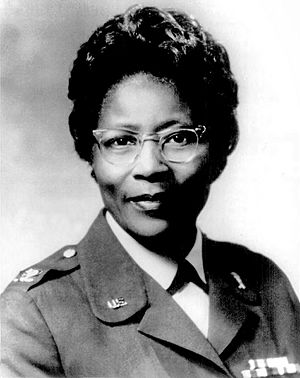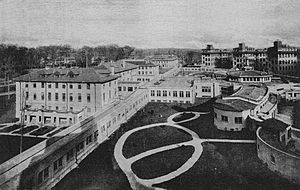Margaret E. Bailey facts for kids
Quick facts for kids
Col
Margaret E. Bailey
|
|
|---|---|
 |
|
| Born | December 25, 1915 Selma, Alabama, US |
| Died | August 28, 2014 (aged 98) Washington, D.C., US |
| Buried |
Arlington National Cemetery Section 55 Site 1081
|
| Allegiance | |
| Branch | United States Army |
| Years of service | 1944 – 1971 |
| Rank | Colonel |
| Unit | United States Army Nurse Corps |
| Conflict | World War II |
| Awards |
|
Margaret E. Bailey (December 25, 1915 – August 28, 2014) was a very important nurse in the United States Army Nurse Corps. She served in the Army for 27 years, from 1944 to 1971. During her time, she worked in countries like France, Germany, and Japan.
Margaret Bailey started as a second lieutenant and rose to the rank of colonel. This was the highest rank a nurse could achieve in the Nurse Corps. She made history for black nurses in the US military. She became the first black lieutenant colonel in 1964. In 1966, she was the first black chief nurse in a mixed unit (where people of all races worked together). Then, in 1967, she became the first black full colonel.
During World War II, Bailey cared for German prisoners of war. Later in her career, she worked hard to get more black people to join the Nurse Corps. After she retired from the Army, she advised the Surgeon General in the Nixon administration. She continued to help increase the number of minorities in the Nurse Corps. For many years, she gave speeches across the United States, supporting equal chances for everyone in the Army.
Contents
Early Life and Dreams
Margaret Bailey grew up in Selma, Alabama, a very segregated area in the South. She was born on December 25, 1915. Her father died when she was eight. Her mother, Hattie Bailey, then moved the family to Mobile, Alabama.
Margaret finished school in Mobile. As a child, she walked past a hospital every day. The neat look of the nurses made her want to become one. During the Great Depression, Margaret worked on school nights and Saturdays to help her family. After high school, she worked for two years to save money for college. In 1935, she was accepted into nursing school in Montgomery, Alabama.
Starting Her Nursing Career
In 1938, Margaret graduated from nursing school. She found a job at Mercy Hospital in St. Petersburg, Florida. This was the only hospital for the local black community at the time.
Finding this job was a big success. There were not many opportunities for black women in the South. Most jobs were cleaning, teaching, or nursing, and always in separate facilities for black people. But a year later, in 1939, Margaret left Mercy Hospital. She found a better nursing job at Seaview Hospital on Staten Island, New York.
Seaview Hospital was the largest hospital in the country for treating tuberculosis. It was also very expensive. Unlike Mercy Hospital, Seaview Hospital was not segregated. It had a history of promoting black nurses to leadership roles. Margaret worked at Seaview Hospital for almost five years. Then, in the summer of 1944, she decided to join the US military.
Serving in the Military
Margaret Bailey joined the United States Army Nurse Corps in June 1944. This was when the Normandy landings were happening in World War II. She wanted to help wounded American soldiers. At that time, the US military was segregated. The Army Nurse Corps did not want to accept black nurses until 1941. This only changed after groups like the National Association of Colored Graduate Nurses and Eleanor Roosevelt pushed for it. Even then, black nurses faced a lot of unfair treatment.
Bailey was first sent to an "all-Negro unit." She completed her basic training at Fort Huachuca in Arizona. She became a second lieutenant. Her first assignment was at a hospital in Florence, Arizona. There, she cared for German prisoners of war.
Over the years, Bailey worked as a medical and surgical nurse in many places. These included France, Germany, and Japan. Even though she faced racism, she slowly moved up in rank. In 1950, she took a special course in psychiatric nursing. This led to her promotion to captain. Margaret was often transferred to new places. But she kept taking evening university classes. She earned enough credits from different universities to get her bachelor's degree in nursing in 1959.
On July 15, 1964, after 20 years of service, Bailey became a lieutenant colonel. She was the first black nurse to reach this rank. In May 1965, the Army's segregation policy ended. She was then moved to a hospital in Chinon, France. This was her first time working in a mixed-race unit. In 1966, she became the chief nurse of that unit. This made her the first black nurse to lead a non-segregated unit.
In February 1969, Bailey received the Army Commendation Medal. Later that year, she moved to Washington D.C. In January 1970, Margaret Bailey became the first black person to reach the rank of colonel. This was the highest military rank possible in the United States Army Nurse Corps.
Bailey retired in July 1971, after 27 years of service. She was seen as an "excellent professional officer." When she retired, she received the Legion of Merit. This is the second-highest award for non-combat service. During her career, she saw the end of segregation in the Army. She also visited 27 countries. In her last years in the military, Bailey spent more and more time helping to recruit black women into the Nurse Corps.
Fighting for Equality
Early in her Army career, especially when she was overseas, Bailey met many people who had never worked with a black woman before. She enjoyed teaching them about black culture. She believed this was important for bringing people together. Later, she strongly supported getting more black women to join the Army. She worked with women's rights groups and spoke publicly about recruiting minorities.
Bailey was a leader in the "integration movement." When segregation in the Army ended in 1965, she called it a "difficult yet rewarding milestone." But at that time, only 6.6% of the Nurse Corps were black. So, Bailey continued her efforts to increase black participation.
After retiring from the Army in 1971, Bailey became a consultant to the Surgeon General. Her special job was to help more minorities join the Army Nurse Corps. The National Association for the Advancement of Colored People praised this. They saw that the Nixon administration was promoting Bailey and other black public servants.
In her later years, Bailey often gave speeches in black communities. She encouraged integration and military service. For example, in 2000, at 84 years old, she traveled to Alabama to speak at a church. Sometimes, she worked with Clara Adams-Ender to promote more black participation in the Army. Bailey spoke at the National Black Nurses Association's meeting in 1998. She also took part in international conferences in South Africa and Botswana.
In 1999, Bailey wrote her autobiography called The Challenge. She was also an active member of Chi Eta Phi. This is a group for registered nurses and nursing students.
Awards and Recognition
Margaret Bailey received many awards for her Army service and her work for equality. Her Army medals included:
- World War II Victory Medal
- American Campaign Medal
- National Defense Medal
- Army Commendation Medal
- Legion of Merit (the second highest non-combat military award)
In 1967 and 1969, several women's groups named her Woman of the Year.
Later Life
Margaret Bailey passed away on August 28, 2014, in Washington D.C. She was buried at Arlington National Cemetery.
See also
Images for kids



